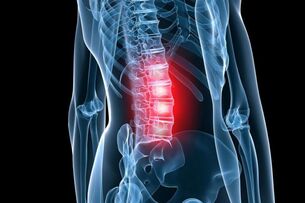
Low back pain bothers many people, regardless of their age and profession. Loaders and office workers, young mothers and retired gardeners, writers and even athletes suffer from them. In each of them, pathological changes can occur in the bone and cartilage tissue of the vertebrae, which leads to compression (compression) of the nerve spinal roots, which causes severe pain.
But painful sensations are only external manifestations of the disease. It is often accompanied by other pathological syndromes that require mandatory treatment, the lack of which often leads to disability and the ability to self-care. In other words, a person becomes disabled.
Description of the disease
Osteochondrosis is caused by unnatural compression of the spine, which causes compression of the intervertebral discs and adjacent tissues of the ligament apparatus. When squeezed from the discs, it leaves a fluid that is responsible for their plasticity and is a source of tissue nutrition with the necessary trace elements. With prolonged adverse effects, the fibrous ring of the intervertebral discs loses its elasticity and density and then breaks, leading to compression of the nerve endings. This causes pain, which is often accompanied by swelling.
In addition, the outer edges of the vertebrae, with an incorrectly distributed load on them, are overgrown with osteophytes - growths of bone tissue. They also cause pain and restrict the movement of the spine, exacerbating the problem.
That is, the disease most often occurs with such loads on the spine, which are incorrectly distributed or stereotyped - are monotonous and recurrent.
Causes
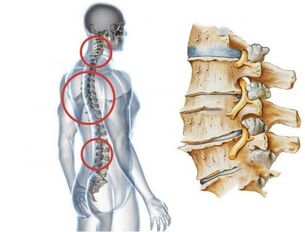
Do not assume that only heavy physical activity or a sedentary lifestyle, in which the muscle frame weakens, leads to osteochondrosis of the lumbar spine. This also happens to very active people who do sports or work daily in their summer villa. If their movements are uniform (lifting the bar, digging the ground), pressure appears on the same points, in the area of which the cartilage tissue is gradually destroyed.
There are other reasons. Among them:
- disorder of calcium metabolism in the body;
- overweight or its serious fluctuations in any direction in compliance with a strict diet, pregnancy, a sharp change in hormone levels;
- spinal cord injury or curvature (scoliosis);
- severe single hypothermia or regular exposure to cold, moisture;
- depressive states, stress;
- constant physical overload;
- bad heredity.
Note. Any strict diet based on the use of one product or a critical reduction in calorie intake leads not only to sudden weight loss, but also to the appearance of a deficiency of valuable trace elements in the body. Which is also bad for muscles and bones.
Symptoms
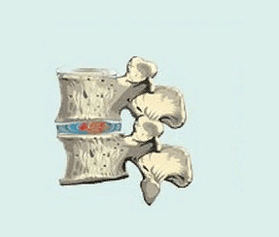
Osteochondrosis is rarely detected in time, as in the initial stage it is asymptomatic. Specifically, there are symptoms, but they are difficult to associate with spinal problems. Therefore, they are most often found accidentally during a comprehensive examination for other health problems.
There are four stages in the development of the disease. Let's describe the symptoms of each.
| Stage | Description |
|---|---|
| First | In the first stage, the processes of sweating are disrupted, a person notices general malaise and rapid fatigue. Some patients report a previously unusual cold in the legs. |
| Second | In the second stage, periodic back pain appears, which indicates that the destruction of cartilage tissue begins. |
| Third | The third stage is characterized by already visible changes. An intervertebral hernia can occur, a curvature of the spine often occurs, and in some cases a hump grows. |
| Fourth | The fourth stage is the most difficult, when it is not necessary to talk about a complete cure due to irreversible changes in the skeleton. In addition to the proliferation of osteophytes and the displacement of the vertebrae, causing acute pain, problems arise in other organs of the pelvis. Often the patient ceases to control the processes of urination and defecation. |
Treatment of diseases
Methods of treating osteochondrosis are chosen depending on the stage of the disease and the severity of the pain. Conservative treatment brings good results only in the initial stages. For example, if osteochondrosis of the lumbar spine was caught in the beginning, you can get rid of it with the help of special exercise, correction of physical activity and body weight, swimming, taking vitamin and mineral complex preparations.
When pain occurs, it is no longer enough. It must be removed along with the cause. Why use drugs, traditional physiotherapy techniques and even alternative medicine methods? And in the later stages only surgical treatment is possible.
Physiotherapy
Hardware physiotherapy methods such as:
are used to relieve pain and swelling, enhance the effect of drugs and reduce their dose.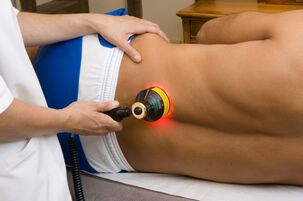
- ultrasound;
- laser;
- magnetic field effect;
- electrophoresis;
- manual therapy, massage.
Note. Massage helps to relieve muscle spasms, improve blood circulation in the affected intervertebral discs and release pinched vessels and nerves. This is done only with the help of hands, but vacuum massage is contraindicated in this disease.
Shock wave therapy
UHT is a relatively new method of treatment, for the application of which the most modern equipment with programmable dosing of shock waves and a system for their direction are used.
The point is that shock waves destroy osteophytes, restoring cartilage tissue. But healthy bones in the spine, as well as major arteries, can also be damaged. That is why it is very important to make sure that this technology is well developed in the hospital and that the treatment is performed by a highly qualified and licensed specialist.
Alternative therapeutic methods
In addition to the standard methods for the treatment of osteochondrosis of the lumbar spine, there are also non-traditional ones. Such methods are constantly being studied and are already being applied in many clinics. These include basically:
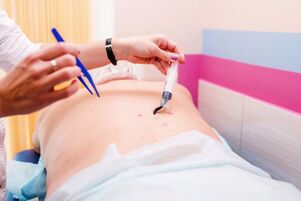
- hirudotherapy or leech therapy helps relieve inflammation and improve blood circulation;
- Acupuncture or acupuncture is an effective way to relieve pain, muscle tension and inflammation. It consists of the introduction of special needles in certain biologically active points of the body;
- ozone therapy - injection of ozone-oxygen mixture. With the right dosage, this method inhibits the growth of osteophytes and relieves painful muscle tone.
In parallel with these methods of treatment or to record the results achieved with their help, a course of kinesitherapy and therapeutic gymnastics is conducted.
Surgical techniques
If the disease has started and conservative treatment does not alleviate the patient's condition, they resort to surgical methods. You can not do without them, if after a few months of active treatment it was not possible to relieve pain and improve the general condition of a person. And especially in cases where there are problems such as reduced potency in men, dysfunction of the pelvic organs, tingling in the perineum.
- Endoscopic microdiscectomy - removal of disc herniation. This is a minimally invasive surgery that relieves compression of the spinal cord or nerve root.
- Laser reconstruction of intervertebral discs can hardly be called an operation. During the procedure, which is performed under local anesthesia, a thin needle is inserted into the affected disc, through which it is irradiated with a laser, which stimulates the division of cartilage cells.
- Foraminotomy is an operation to remove the processes of the vertebrae or part of the disc, aimed at releasing a pinched nerve.
- Vertebroplasty - injection of bone cement into the destroyed spinal tissue in order to strengthen.
- Osteotomy - removal of diseased vertebrae and discs with subsequent replacement with prostheses.
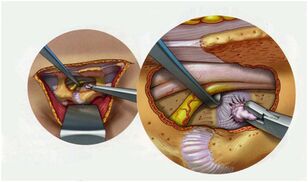
There are other methods aimed at stabilizing the vertebrae, their decompression, removal of osteophytes and more. Each of them requires a long recovery period. After surgical treatment of the spine, the patient should not get up, walk, bend over or experience physical stress for a long time. This leads to muscle relaxation and partial loss of motor functions that require support and rehabilitation. Therefore, at the end of the postoperative period begins a period of recovery and rehabilitation, whose task is to restore motor functions in full and prevent complications in the pelvic organs.
At this stage, some of the above methods of conservative treatment are applied, the correct posture is developed, the usual movements are corrected. In this case, the patient is advised to wear a special fixing corset. An individual set of exercises is then compiled, which must be performed daily and for life to prevent recurrence of the disease.

























